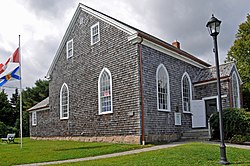Municipality of the District of Guysborough
Guysborough | |
|---|---|
| Municipality of the District of Guysborough | |
 | |
 Location of the Municipality of the District of Guysborough | |
| Coordinates: 44°26′00″N 064°35′57″W / 44.43333°N 64.59917°W | |
| Country | Canada |
| Province | Nova Scotia |
| County | Guysborough |
| Incorporated | April 17, 1879 |
| Government | |
| • Type | Council of the Municipality of the District of Guysborough |
| • Municipal Seat | Guysborough |
| • Warden | Paul Long |
| Area | |
| • Land | 2,116.86 km2 (817.32 sq mi) |
| Population (2016)[2] | |
• Total | 4,670 |
| • Change 2011-16 | |
| • Census ranking | 751 of 4,870 |
| Electoral districts | |
| • Federal | Cape Breton—Canso |
| • Provincial | Guysborough–Eastern Shore–Tracadie |
| Time zone | UTC-4 (AST) |
| • Summer (DST) | UTC-3 (ADT) |
| Area code | 902 |
| Dwellings | 2,889 |
| Median Income* | $34,987 CDN |
| Website | www |
| |
Guysborough, officially the Municipality of the District of Guysborough, is a Canadian district municipality in Guysborough County, Nova Scotia. The municipal office is located in Guysborough.
History
[edit]The area was originally inhabited by the Mi'kmaq, who had seasonal settlements on the coast of Chedabucto Bay at Cooks Cove and Canso. The Mi'kmaq extensively used the waterways feeding into Chedabucto Bay as trade and travel routes.
The area was visited by European fishermen in the early 16th century, and the first attempt at settlement was made in 1518 at Canso. Canso became a centre for fishing and fur trading activity in the region.
French Settlement
[edit]The French established control over the area in the early 17th century. A Catholic mission was established at present day Guysborough (called Chedabuctou by the French) in 1627, with a French fort first being constructed in 1632. In 1654, Nicolas Denys expanded on the previous fort and made an attempt at settlement. In 1682, a permanent settlement was established by Clerbaud Bergier. A significant fortification was built to establish control over the region and it's fishery.
Following Queen Annes War, the area was contested between France and Britain. The British established a presence at Canso in 1720, and the area became a highly fought over location until France's final expulsion from the region during the French and Indian War. Much of the Acadian population left in the 1750's and 60's amidst the Acadian Expulsion.
British Settlement
[edit]British settlers began arriving shortly after the departure of the Acadians. A large influx of settlers arrived in the form of Loyalists and former British soldiers in the aftermath of the American Revolutionary War. The community of Guysborough was established by the Loyalists, named in honour of Sir Guy Carleton[3].
The area was originally part of Sydney County, from which Guysborough County was split in 1836. In 1840, Guysborough County was subdivided into two districts for court sessisonal purposes – Guysborough and St. Mary's. In 1879, the two districts were incorporated as district municipalities.
Recent History
[edit]In a plebiscite held on July 12, 2008, residents of the Town of Canso narrowly voted to amalgamate the town with the Municipality of the District of Guysborough. On January 19, 2012, the Nova Scotia Utility and Review Board granted the town's application to dissolve. On July 1, 2012, Canso became part of the Municipality of the District of Guysborough.
Geography
[edit]Occupying the eastern half of Guysborough County, the district municipality's administrative centre is the community of Guysborough. The district completely surrounds the Town of Mulgrave and it borders the Municipality of the District of St. Mary's to the west, the Municipality of the County of Antigonish to the north and the Strait of Canso to the east.[citation needed]
Demographics
[edit]In the 2021 Census of Population conducted by Statistics Canada, the Municipality of the District of Guysborough had a population of 4,585 living in 2,220 of its 3,043 total private dwellings, a change of -1.8% from its 2016 population of 4,670. With a land area of 2,115.25 km2 (816.70 sq mi), it had a population density of 2.2/km2 (5.6/sq mi) in 2021.[4]
|
|
Notable Locations
[edit]National Historic Sites
[edit]- Canso Islands National Historic Site
Provincial Parks
[edit]- Black Duck Cove Provincial Park
- Boylston Provincial Park
- Port Shoreham Beach Provincial Park
- Salsman Provincial Park
- Tor Bay Provincial Park
Wilderness Areas
[edit]- Bonnet Lake Barrens Wilderness Area
- Canso Coastal Barrens Wilderness Area
- Ogden Round Lake Wilderness Area
See also
[edit]References
[edit]- ^ a b 2006 Statistics Canada Community Profile: Guysborough Municipal District, Nova Scotia
- ^ "Population and dwelling counts, for Canada, provinces and territories, and census subdivisions (municipalities), 2016 and 2011 censuses – 100% data (Nova Scotia)". Statistics Canada. February 8, 2017. Retrieved February 12, 2017.
- ^ "Place-names of the Province of Nova Scotia". Halifax, N.S. Royal Print. & Litho. 1922.
- ^ "Population and dwelling counts: Canada, provinces and territories, census divisions and census subdivisions (municipalities), Nova Scotia". Statistics Canada. February 9, 2022. Retrieved March 12, 2022.
- ^ Statistics Canada: 1996, 2001, 2006 census
- ^ 2011 Census
External links
[edit] Media related to Municipality of the District of Guysborough at Wikimedia Commons
Media related to Municipality of the District of Guysborough at Wikimedia Commons- Official website

